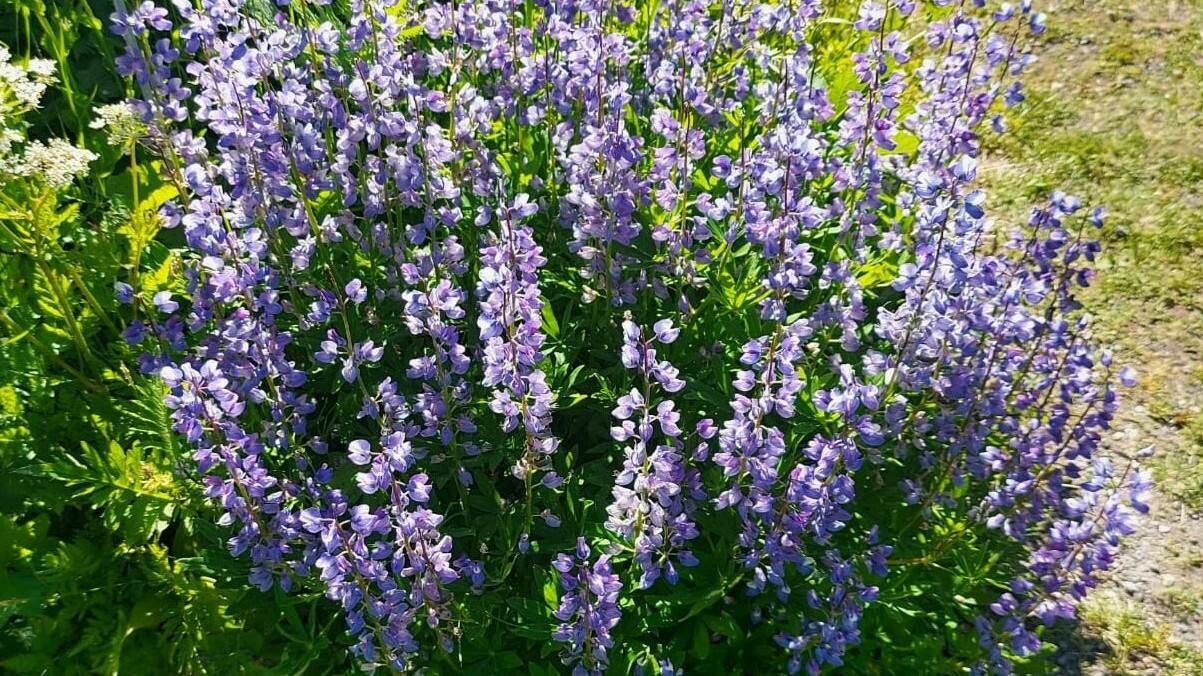Nootka Lupine
lupinus nootkatensis
Also known as: ["Nootka Lupin","Alaska Lupine"]
Overview
A perennial herbaceous plant native to coastal regions of North America, known for its tall spikes of pea-like flowers in shades of blue, purple, or white.
Benefits & Perks
["long-flowering","wildlife attractant (bees, butterflies, birds)","drought tolerant","shade tolerant"]
Botanical Classification
| Phylum: | Magnoliophyta |
| Class: | Magnoliopsida |
| Order: | Fabales |
| Family: | Fabaceae |
| Genus: | Lupinus |
| Botanical Name: | Lupinus nootkatensis |
Plant Characteristics
Basic Information
- Category: Flowers
- Suitable Location: outdoor garden bed in open, sunny area
- Suitable For:
- Is Weed: No
- Allergenicity: low
Environmental Needs
- Climate: {"temperatureRange":"0–30°C"}
- Hardiness: {"zones":"4–8"}
- Misting: rarely required, only if ambient humidity is very low
- Drainage: Well-draining but moisture-retentive.
- Soil Type: Rich, loamy soil with good organic matter.
Maintenance Level
- Maintenance Level: low
- Toughness Level: high
- Pruning Frequency: After flowering; as needed to remove dead or damaged stems.
- Pruning Intensity: Light to moderate.
Care Details
Ideal Sunlight Coverage:
Full sun (6–8 hours/day). Tolerates partial shade but blooms best in direct light.
Sunlight Tolerance Tips:
Acclimate plants gradually to intense sun; protect from harsh afternoon sun in hot climates; ensure good air circulation to prevent leaf scorch.
Care Requirements
Care Difficulty
easymoderate
Sunlight
full sun
Rotate plants for even light; use shade cloth in extreme heat; avoid direct sun on leaves during peak hours.
Watering
every 7–10 days during active growth, reduce in winter
Water at the base to avoid foliage wetting; ensure soil dries slightly between waterings; avoid overwatering.
Soil
well-drained, sandy loam with moderate fertility
pH: Slightly acidic to neutral (pH 6.0–7.0).
Avoid heavy clay; ensure organic content; test pH annually.
Temperature
Cool to moderate temperatures (50–70°F/10–21°C). Prefers cooler summers and tolerates mild frosts.
Avoid sudden temperature shifts; maintain consistent cool nights; protect from frost.
Fertilizing
every 4–6 weeks during spring and summer
Fertilize sparingly; apply before flowering; stop in late summer.
Propagation
Methods
Seed or basal cuttings.
Step-by-Step Propagation Guide
- Take cuttings.
- Apply hormone.
- Plant in medium.
- Maintain humidity.
- Transplant when rooted.
Best Time: Spring or early summer for cuttings; autumn for seeds.
Environment
High humidity (70–80%), indirect light, and consistent warmth (60–65°F/15–18°C).
Medium
Well-draining mix of peat and perlite or cactus soil.
Hormone
Optional, but rooting hormone can improve success rates for cuttings.
Timeline
4–6 weeks for roots; 3–4 months to establish.
Tools Needed
Pruners, rooting hormone, pots, humidity dome, misting spray.
Quick Tips
Use fresh seeds for germination; keep cuttings moist; avoid direct sun during rooting.
Pruning & Repotting
Pruning Guide
Method
Deadhead flowers; trim back to healthy growth; avoid cutting into old wood.
Pruning Plan
Remove spent flower spikes to encourage reblooming; trim leggy growth to maintain shape.
Tools
Pruning shears, gloves, disinfectant.
Checklist
Clean tools; deadhead; trim weak growth; dispose of clippings.
Repotting Guide
Best Season
Early spring before active growth.
Pot Size
One size larger pot; ensure it’s not too deep.
Method
Use fresh soil mix; tease out crowded roots; ensure good drainage.
Suggestions
Repot every 2–3 years or when roots fill the container.
Checklist
Prepare new pot; water plant before repotting; handle roots gently; backfill with soil.
Advanced Care Tips
Watering Mastery
Watering Checklist
Check soil moisture; water deeply; ensure drainage; adjust seasonally.
How to Apply Water Properly
Water thoroughly until it drains from the bottom, ensuring root zone saturation. Water early in the morning to minimize evaporation and fungal risk.
Watering Schedule Tips
Water deeply once a week during active growth, reducing frequency in winter. Adjust based on rainfall and soil moisture.
Soil Improvement
Add compost or well-rotted manure; incorporate perlite for drainage; use mulch to retain moisture.
Temperature Stress Management
Signs of Temperature Issues
Wilting, leaf yellowing, or stunted growth in excessive heat; leaf drop or browning in cold stress.
Cold Stress
Slows growth; may cause leaf damage or dieback in prolonged freezing conditions.
Solution: Mulch heavily in winter; protect from harsh winds; move potted plants to sheltered areas.
Hot Stress
Leaves may scorch, flowers fade quickly, and growth may halt in excessive heat.
Solution: Provide shade during peak sun; increase watering; use reflective mulch to reduce soil heat.
Fertilizing Guide
Fertilizing Checklist
Use balanced fertilizer; apply at half strength; avoid foliage contact.
Fertilizing Method
Use a balanced, slow-release fertilizer in early spring. Avoid high-nitrogen formulas to prevent excessive foliage growth over blooms.
Common Problems & Solutions
Toxicity Warning
Cats
ToxicCats are susceptible to the toxic effects of quinolizidine alkaloids found in Lupinus nootkatensis. Ingestion can result in severe gastrointestinal and neurological symptoms, including muscle tremors and potential paralysis.
⚠️ Symptoms:
🌿 Toxic Parts:
⚡ Toxic If:
if eaten
Dogs
ToxicThe quinolizidine alkaloids in Lupinus nootkatensis are toxic to dogs, causing gastrointestinal upset and neurological symptoms. The toxins can lead to muscle weakness, tremors, and in severe cases, respiratory paralysis.
⚠️ Symptoms:
🌿 Toxic Parts:
⚡ Toxic If:
if eaten
Humans
ToxicLupinus nootkatensis contains quinolizidine alkaloids, primarily lupanine, which are toxic to humans. Ingestion can lead to neurological and gastrointestinal disturbances, with severity depending on the quantity consumed. The alkaloids interfere with neurotransmitter function and can cause muscle weakness and paralysis in severe cases.
⚠️ Symptoms:
🌿 Toxic Parts:
⚡ Toxic If:
if eaten
Frequently Asked Questions
Q: Is Nootka Lupine toxic to pets?
A: Yes, it is mildly toxic to dogs and cats if ingested.
Q: Does Lupinus nootkatensis attract wildlife?
A: Yes, it attracts bees, butterflies, and birds.
Q: How much maintenance does this plant require?
A: It requires low maintenance and is drought tolerant.
Quick Reference
| Family: | Fabaceae |
| Care: | easy |
| Light: | full sun |
| Water: | every 7–10 days during activ |
Get Expert Care Tips
Download the Plantious app for personalized care reminders and plant identification!
Google Play App Store






